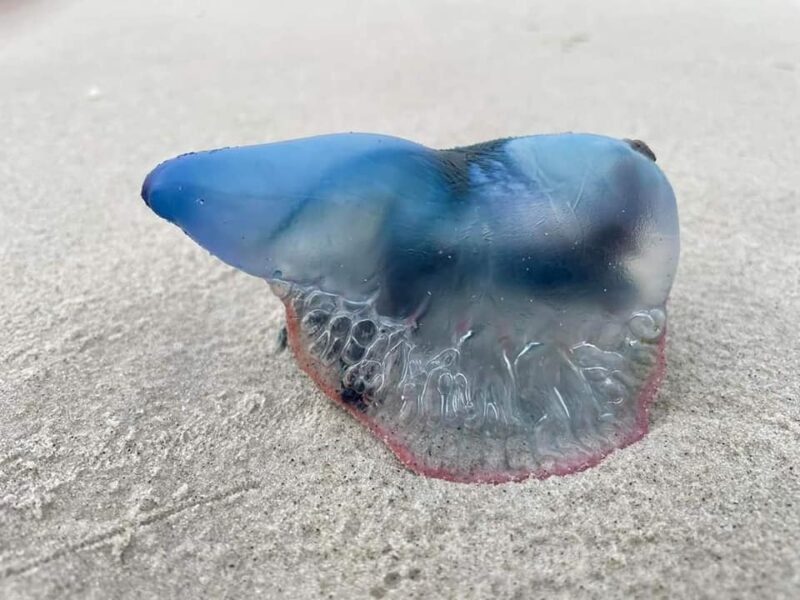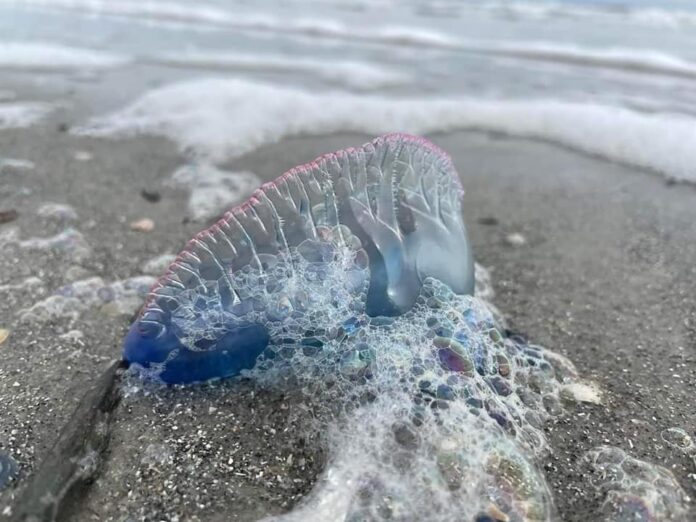Nobody likes to run into a jellyfish when enjoying an afternoon on one of our local Beaufort beaches, but they’re almost always present. We see them washed up on the beach all the time, and sometimes we even see them when we’re swimming.
Few marine creatures are as mysterious and intimidating as jellyfish. Though easily recognized, these animals are often misunderstood and feared by beach goers, even though most jellyfish in South Carolina waters are harmless.
Here are a few things to know about jellyfish in Beaufort, and their close cousins, the man o’ war, which globally sting about 150 million people a year.
Don’t pee on that sting!
Perhaps one of the greatest myths of all time, practically everybody says, “just pee on it.” The truth is, urinating on a jellyfish sting actually makes things worse. SCDNR warns, “applying any form of alcohol, or urine may increase the pain and cause severe skin reactions.” So if you’re standing on a beach in Beaufort with a jellyfish sting, it’s probably not a good idea to pee on it.
SCDNR also offers these tips if stung by a jellyfish.
The victim should carefully remove the tentacles that adhere to the skin by using sand, clothing, towels, seaweed or other available materials.
Remove any tentacles. As long as tentacles remain on the skin, they will continue to discharge venom.
A variety of substances may reduce the effects of jellyfish stings. Meat tenderizer, sugar, vinegar, plant juices and sodium bicarbonate have all been used with varying degrees of success.
Victims of serious stings should get out of the water as soon as possible to avoid drowning. If swelling and pain from more serious stings persist, prompt medical attention should be sought.
Recovery periods can vary from several minutes to several weeks.
Most jellyfish found in S.C. waters are harmless.
Although most jellyfish in Beaufort waters are harmless to humans, there are a few that require some serious caution. Learning how to identify the different species can help you decide which ones can be safely ignored. SCDNR lists those we may see in S.C. waters.
A safe thing to remember is, if the jellyfish is blue, it’s not for you. All jellyfish having a blue float should be considered dangerous.

Cannonball Jelly
Cannonball jellyfish are the most common jellyfish in our area, and fortunately, one of the least venomous. During the summer and fall, large numbers of this species appear near the coast and in the mouths of estuaries. Cannonball jellies have round white bells bordered below by a brown or purple band. They have no tentacles, but they do have a firm, chunky feeding apparatus formed by the joining of the oral arms.
They’re also the favorite food for our nesting loggerhead sea turtles.
Lion’s Mane
Also known as the winter jelly, the lion’s mane typically appears during colder months. The bell, measuring 6-8 inches, is saucer-shaped with reddish-brown oral arms and eight clusters of tentacles hanging underneath. Stinging symptoms are similar to those of the moon jelly but, usually more intense. Pain is relatively mild and often described as burning rather than stinging.
Mushroom Jelly
The mushroom jelly resembles the cannonball jelly, but differs in many ways. The larger mushroom jelly, growing 10-20 inches in diameter, lacks the brown band of the cannonball and is much flatter and softer. Like the cannonball, the mushroom jelly has no tentacles and a chunky feeding apparatus, but differs in its long fingerlike appendages that hang from the feeding apparatus.
Southern Moon Jelly
Probably the most widely recognized jellyfish, the moon jelly occurs infrequently in South Carolina waters. It has a transparent, saucer-shaped bell and is easily identified by the four pink “horseshoes” visible through the bell. It typically reaches 6-8 inches in diameter, but some exceed 20 inches. The moon jelly is only slightly venomous. Contact can produce prickly sensations to mild burning. Pain is usually restricted to immediate area of contact.
Sea Nettle
Common in the summer, this jellyfish is saucer-shaped, usually brown or red, and 6-8 inches in diameter. Four oral arms and long marginal tentacles hang from the bell and can extend several feet. Considered moderate to severe, sea nettle stings are similar to those of the lion’s mane. This species causes most of the jellyfish stings that occur in South Carolina waters. Exercise caution if sea nettles are observed in the water, and do not swim if large numbers are present.
Sea Wasp
Known as the box jelly because of its cube-shaped bell, the sea wasp is the most venomous jellyfish inhabiting our waters. Their potent sting can cause severe skin irritation and may require hospitalization. Sea wasps are strong, graceful swimmers reaching 5-6 inches in diameter and 4-6 inches in height. Several long tentacles hang from the four corners of the cube. A similar species, the four-tentacled Tamoya haplonema, also occurs in our waters.
Portuguese Man-of-War
Although closely related to jellyfish, the Portuguese man-of-war is not a “true” jellyfish. These animals consist of a complex colony of individual members, including a float, modified feeding polyps and reproductive medusae.
They typically inhabit the tropics, subtropics and Gulf Stream but we see these “jellyfish” in Beaufort occasionally. Propelled by wind and ocean currents, they sometimes drift into nearshore waters of South Carolina. Though they visit our coast only infrequently, swimmers should learn to identify these highly venomous creatures.
The gas-filled float of the man-of-war is purple-blue, up to 10 inches long. Under the float, tentacles equipped with thousands of stinging cells hang from the feeding polyps which extend as much as 30 to 60 feet.
The man-of-war can inflict extremely painful stings. Symptoms include severe shooting pain described as a shock-like sensation, and intense joint and muscle pain. Pain may be accompanied by headaches, shock, collapse, faintness, hysteria, chills, fever, nausea and vomiting.
Initial contact with a man-of-war may produce only a small number of stings. But trying to escape from the tentacles may greatly increase stings. Severe stings can occur even when the animal is beached or dead.
Another jellyfish, the smaller by-the-wind-sailor, also has a blue bladder and occasionally enters South Carolina coastal waters, but causes only a mild, tingling sting. Given the significant danger of the man-of-war, all jellyfish having a blue float should be considered dangerous.
Also, the NOAA’s National Ocean Service puts jellyfish on its list of the most hazardous seafaring creatures, joining sea urchins, lionfish, stingrays and sharks.
“These squishy critters injure beach-goers far more often than any other type of sea life. Since a sting from jellyfish tentacles can prove painful even when the creature is dead, smart beach-goers everywhere give them a wide berth both in the water and along the shore,” the NOS website says.
Scientists believe that jellyfish may have existed up to 700 million years ago, making them older than dinosaurs and trees. They can range in size from microscopic to 6 1/2 feet, with weights of up to 440 pounds.










